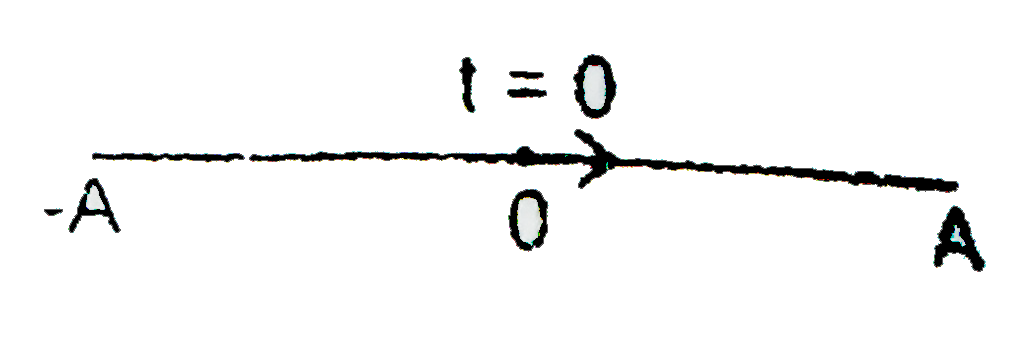Can we use the equation v=u+ at in SHM or not ?
The correct Answer is:A
To determine whether we can use the equation v=u+at in Simple Harmonic Motion (SHM), we need to analyze the nature of acceleration in SHM.
1. Understanding the Equation: The equation v=u+at is one of the equations of motion, where:
- v = final velocity
- u = initial velocity
- a = acceleration (assumed to be constant)
- t = time
2. Nature of Acceleration in SHM: In SHM, the acceleration is not constant. Instead, it is given by:
a=−ω2x
where ω is the angular frequency and x is the displacement from the mean position. This means that the acceleration depends on the displacement x.
3. Dependence on Displacement: Since the acceleration in SHM varies with displacement, it is not a constant value. As x changes, a changes accordingly. This is a key characteristic of SHM.
4. Conclusion: Because the equation v=u+at requires a constant acceleration, and since the acceleration in SHM is variable (dependent on x), we conclude that this equation cannot be used in the context of Simple Harmonic Motion.
Final Answer:
No, we cannot use the equation v=u+at in Simple Harmonic Motion because the acceleration is not constant; it varies with displacement.
- v = final velocity
- u = initial velocity
- a = acceleration (assumed to be constant)
- t = time
a=−ω2x
where ω is the angular frequency and x is the displacement from the mean position. This means that the acceleration depends on the displacement x.
No, we cannot use the equation v=u+at in Simple Harmonic Motion because the acceleration is not constant; it varies with displacement.
Topper's Solved these Questions
- SIMPLE HARMONIC MOTIONBOOK - DC PANDEY ENGLISHCHAPTER - SIMPLE HARMONIC MOTIONEXERCISE - Intro. Exer.
1 Videos
- SIMPLE HARMONIC MOTIONBOOK - DC PANDEY ENGLISHCHAPTER - SIMPLE HARMONIC MOTIONEXERCISE - Exercise 14.2
5 Videos
- SIMPLE HARMONIC MOTIONBOOK - DC PANDEY ENGLISHCHAPTER - SIMPLE HARMONIC MOTIONEXERCISE - Level 2 Subjective
18 Videos
- SEMICONDUCTORS AND ELECTRONIC DEVICESBOOK - DC PANDEY ENGLISHCHAPTER - SEMICONDUCTORS AND ELECTRONIC DEVICESEXERCISE - More than One Option is Correct
3 Videos
- SOLVD PAPERS 2017 NEET, AIIMS & JIPMERBOOK - DC PANDEY ENGLISHCHAPTER - SOLVD PAPERS 2017 NEET, AIIMS & JIPMEREXERCISE - Solved paper 2018(JIPMER)
38 Videos
Similar Questions
Can we use the equations of rotational motion if θ is measured in degrees and not in radian ?
View SolutionCan we derive the kinematic relations V= u+ at , S = ut = 12at2andV2=u2+ 2as. Explain the reason for your answer.
View SolutionSelect the correct statements for the equilibrium under standard conditions.
H2O(s)⇔H2O(l),ΔSΘ1
H2O(l)⇔H2O(g),ΔSΘ2
H2O(s)⇔H2O(g),ΔSΘ3
View SolutionHow can we make a chemical equation more informative?
View SolutionA particle start form mean position and moves towards positive extreme as shown. Find the equation of the SHM. Amplitude of SHM is A.

View SolutionLet the sides of a parallelogram be U=a,U=b,V=a' andV=b', where U=lx+my+n,V=l'x+m'y+n'. Show that the equation of the diagonal through the point of intersection of U=a,V=a' and U=b,V=b' is given by det ⎡⎢⎣UabVa'b'111⎤⎥⎦=0.
View SolutionLet the sides of a parallelogram be U=a, U=b,V=a' and V=b', where U=lx+my+n, V=l'x+m'y+n'. Show that the equation of the diagonal through the point of intersection of
U=a,V=a'andU=b,V=b' is given by ∣∣ ∣∣UV1aa'1bb'1∣∣ ∣∣=0.
View SolutionIf the roots of the equation x3−10x+11=0 are u, v, and w, then the value of 3cosec2(tan−1u+tan−1v+tan−1w is ____
View SolutionDerive following equations for a uniformly accelerated motion :
(i) v = u + at
(ii) S=ut+12at2
(iii) v2=u2+2aS
Where the symbols have their usual meanings .
View SolutionWrite the equation of SHM for the sitution shown below :
_S01_004_Q01.png)
View Solution
